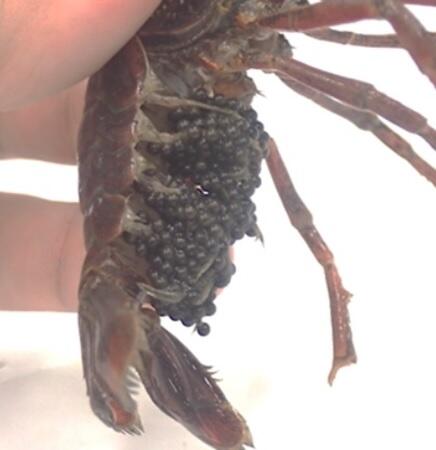The Ministry of the Environment and the Ministry of Agriculture, Forestry and Fisheries designated the red swamp crayfish as a conditionally specified invasive alien species in June 2023. As a result of this, control of the species is being promoted both domestically and internationally. However, the effective control requires knowledge of its reproductive biology, such as its spawning period. Although many Japanese are familiar with the red swamp crayfish, its reproductive biology and life history are surprisingly unknown.
A research group led by Postgraduate Student Quang-Tuong Luong (at the time of research), Professor Kazuyoshi Nakata and Assistant Professor Koki Katsuhara of the Graduate School of Environmental at Okayama University conducted a quantitative survey of red swamp crayfish settled in a pond in Okayama Prefecture, sampling them once or twice a month for one year using both shrimp cage traps and hand nets. The research group revealed new insights into their reproductive biology. The results were published in the electronic version of the Journal of Crustacean Biology.

Provided by Kazuyoshi Nakata, Okayama University
The survey results showed that ovigerous (i.e., egg-carrying) females appeared from late July through October. In other words, the study site in Okayama Prefecture revealed that the breeding season for red swamp crayfish is from summer to fall. The number of eggs carried by 15 ovigerous females was counted and ranged from 100 to 375 eggs per female.
The research group found that females with a larger body size (i.e., longer postorbital carapace length) carried a significantly higher number of eggs, and an equation was established for the relationship between the postorbital carapace length and the number of eggs carried by females.
As a result, the research group had demonstrated the high fecundity (fertility) of the red swamp crayfish, as the number of eggs carried by females of the endemic (native) Japanese crayfish species is only a few dozen in comparison.
Females with hatchlings in their abdomens were continuously observed from early October to mid-February of the following year. Although the rate of egg development in aquatic animals is significantly slower at low water temperatures, females that spawn late in the fall have been found to spend the winter with their eggs, and egg development progresses gradually to hatching even at low water temperatures during the winter.
Mature crayfish males are known to have two reproductive statuses with distinct morphological forms: Form I, when they can reproduce; and Form II, when they cannot reproduce. Moreover, Form I and Form II alternate with each molt or form alternation. In this study, the researchers first observed that the size of small projections (hooks) on the third and fourth pereiopods (walking legs) of adult males differed significantly between Forms I and II. The hooks that develop in Form I during the fertile period are speculated to help hold the female in place during mating. Since it is easy for anyone, even a non-expert, to distinguish between Forms I and II simply by judging the hook size, this physical feature may be a useful indicator for assessing whether mature males removed during red swamp crayfish control are breeding or nonbreeding forms.
The researchers hope that the knowledge gained from this study will lead to more efficient control of this invasive species. Luong commented, "I am currently conducting research at a university in Vietnam, and I believe that the skills and knowledge on invasive species control that I acquired during my PhD studies at Okayama University will help my future work in maintaining a sustainable freshwater ecosystem in Vietnam. In Southeast Asia, including Vietnam, there is a lack of knowledge about the distribution of alien crayfish species, such as the red swamp crayfish, which we hope to address in the future."
Nakata said, "I have been studying crayfish for about 25 years, but this research marked the first time I noticed that the size of the hooks on the pereiopods of adult male red swamp crayfish changed with each molt. I realized that I still did not have a good understanding of crayfish species and also realized the depth of the ecology of the creatures. Through predation and other means, this species causes extensive damage to aquatic organisms, including endangered species. We hope that these results will lead to more effective control."
This article has been translated by JST with permission from The Science News Ltd. (https://sci-news.co.jp/). Unauthorized reproduction of the article and photographs is prohibited.




